new posts in all blogs
Viewing: Blog Posts Tagged with: Hudson River School, Most Recent at Top [Help]
Results 1 - 25 of 26
How to use this Page
You are viewing the most recent posts tagged with the words: Hudson River School in the JacketFlap blog reader. What is a tag? Think of a tag as a keyword or category label. Tags can both help you find posts on JacketFlap.com as well as provide an easy way for you to "remember" and classify posts for later recall. Try adding a tag yourself by clicking "Add a tag" below a post's header. Scroll down through the list of Recent Posts in the left column and click on a post title that sounds interesting. You can view all posts from a specific blog by clicking the Blog name in the right column, or you can click a 'More Posts from this Blog' link in any individual post.
This unfinished Maine seacoast study by Hudson River School artist
William Hart (1823 – 1894) gives an insight into his oil painting method.

It appears that he has pre-toned the canvas in the lower area with a thin layer of burnt sienna which was dry when he arrived the location. The gray area of the beach at lower left and the blue colors of the sea at right are laid opaquely over the warm underpainting.
Those blue colors are just a flat base coat that, had there been time to finish, would have been detailed with waves. The top area of the rocks are subdivided further and further with the brush, progressing from large forms to small ones.
 |
| William Hart, White Pine, Shokan, Ulster County, New York, c. 1850-'60 |
The idea of laying large, flat areas and subdividing them applies to Hart's watercolors as well. He lays down the entire silhouette shape of the tree mass in a flat, dull-green tone, preserving the white of the paper where he needs it. Then he systematically subdivides those green tones with smaller forms.
-----
Watercolor from Albany InstituteMore insights on Hart on
Mike Ettner's blog
Jervis McEntee (1828-1891), was a painter of the Hudson River School who has been largely overlooked until now. His work is being featured in two different museum exhibitions this fall, one in Kingston, and the other in New Paltz, New York.
The Kingston exhibit is a small show, but it has a variety of attractions, including easel paintings, location studies in oil, pencil sketches, photographs, letters, and other documentary material, all of which puts McEntee in a historical context.
McEntee began studying with Frederic Church in 1850, and learned from him a love of painting faithful small studies of forest scenes, sunsets, and trees. They traveled together on painting junkets to Mexico and other locations throughout their lives.
The son of an engineer who helped develop the bustling D&H barge canal that terminated in Kingston, McEntee himself avoided industrial subjects, and gravitated instead to the bucolic scenes that were fast receding in 19th century America.
His circle of friends included notable writers, actors, architects. Among his artist friends were not only Frederic Church, but also Sanford Gifford, John F. Weir, and Worthington Whittredge.
McEntee and his wife occupied one of the legendary
Tenth Street Studios in New York, a fertile meeting ground for artists and illustrators in late 19th century America.
He was frequently depressed as his fortunes ebbed. The journal makes for fascinating reading, because he had the same problems with galleries that contemporary painters do. On
January 4, 1883, he wrote: "Beginning to be worried with money anxieties. They don't send my money for my picture sold in Brooklyn nor reply to my inquiries. I can't stand being asked for money when I have none."
 |
| Jervis McEntee, View Facing the Catskills, 1863, oil, Private Collection |
The second exhibition just opened at the
Samuel Dorsky Museum on the campus of the State University in New Paltz.
 |
| Jervis McEntee, Autumn Reverie, 1880, oil on canvas, David and Laura Grey Collection |
It's a larger exhibition with more finished paintings, borrowed from the Metropolitan Museum, the Brooklyn Museum, and many other public and private collections.
Kingston Exhibition: "Jervis McEntee: Kingston’s Artist of the Hudson River School" is at the
Friends of Historic Kingston gallery at 63 Main St. in Kingston and will run through October. The museum is only open Fridays and Saturdays from 11 am to 4 pm through Oct. 31, 2015. There will be "Noontime Conversations" by noted artists and art historians held on Fridays during the month of September.
The catalog of the Kingston show is called
Jervis McEntee: Kingston's Artist of the Hudson River School
. It's 62 pages, softcover, with contributions by Lowell Thing and Jane Kellar.
New Paltz Exhibition: The New Paltz exhibition is called "
Jervis McEntee: Painter-Poet of the Hudson River School" It will be on view at the Samuel Dorsky Museum in New Paltz through December 13.
The New Paltz show catalog is titled
Jervis Mcentee: Painter-Poet of the Hudson River School. This 130-page monograph presents new scholarship by exhibition curator Lee A. Vedder along with contributions by Kerry Dean Carso, a scholar of the historic Hudson Valley and professor at SUNY New Paltz; and American studies professor David Schuyler, the leading historian on McEntee.
----
Jervis McEntee on Wikipedia
William Trost Richards painted Into the Woods when he was about 27 years old. It's in oil, and it's not large (15.5 x 20 inches / 39.7 x 51 cm).
 |
| William Trost Richards, Into the Woods, oil/canvas, 1860 |
I would guess that it was painted entirely on the spot in at least a dozen sittings, and probably in at least two different locations. As with some of Asher B. Durand's woodland studies, the foreground and background seem to be composited together. Such complete vistas rarely exist readymade in nature.
The painting caught the attention of the art public of his time. He had read
Elements of Drawing and
Modern Painters, the books by John Ruskin which urged young artists to be absolutely faithful to the small details of nature.
Several artists tried to take up the idea, but WTR did so with the most tenacity. One observer said "he persisted, and carried imitation in art further" than the other pioneers. Another commentator noted that he had "a slow, keen vision, and a slow, sure hand."
Other critics argued that he missed the poetry for the details. In fact, WTR shifted his attention more to express the moods of light and atmosphere in his later canvases. Ruskin suggested that young artists begin by modeling themselves after the Pre-Raphaelites, and with that under their belts, try to emulate the more evocative aspects of Turner.
The painting is in the collection of the
Bowdoin College Museum of Art, Brunswick, Maine Previously on GJ:
Foliage / Forest Interiors
The largest collection of outdoor paintings by
Frederic Church (1826-1900) is held by the Cooper Hewitt museum in New York City. They acquired about 2000 of them back in 1917 when Church's son, Louis Palmer Church, was cleaning out the attic.
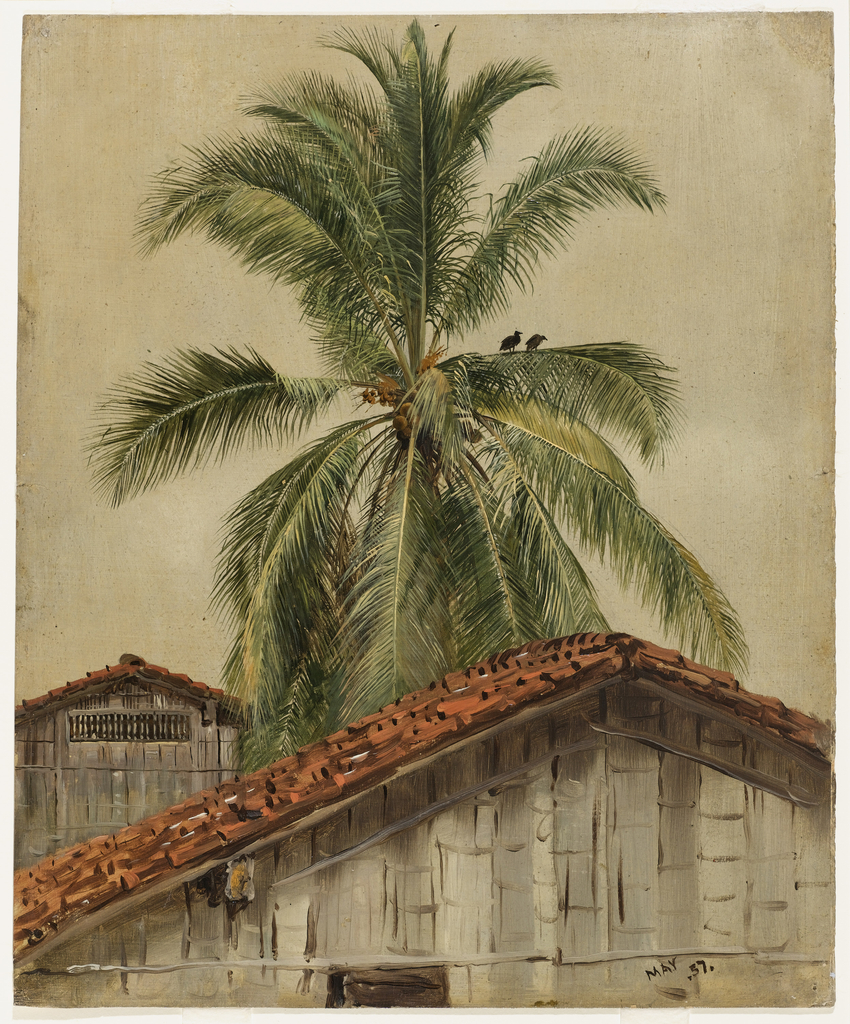 |
| Frederic Church, Palm Trees and Housetops, Ecuador, May 1857, Cooper Hewitt |
Church's field studies are notable for their precision, delicacy, and uber-photographic clarity. He made them not to sell, but as references for his epic studio canvases.
Church's field studies were painted on paperboard, and are fairly small. This tree study is just 9 x 12.
As finicky and precise as these paintings look, they are painted very efficiently. The sun and clouds moved through the sky as fast for Church as they do for us!
The paint is applied thinly over a graphite preliminary drawing. Sometimes the drawing is visible through the paint.
This unfinished sketch of Jerusalem from 1868 shows how he covered the pencil drawing in an "area-by-area" method, thinly, from top to bottom.
Because of the way oil paint can retain its brush character when it is scrubbed on, he suggests a lot of detail with a bristle brush. The foreground trees seem to have their full complement of leaves, but the light leaf textures are the light-toned board showing through. The line of trees at the bottom probably went down in a matter of seconds.
Find out more
• The Cooper Hewitt is currently exhibiting some of the sketches at the Metropolitan Museum through a
special arrangement, since the Met doesn't own any of his studies.

American impressionist Walter Launt Palmer (1854–1932) was known for three themes: snowy forests, Venetian lagoons, and opulent interiors. To all three of those subjects he brought an evocative feeling for light and color.
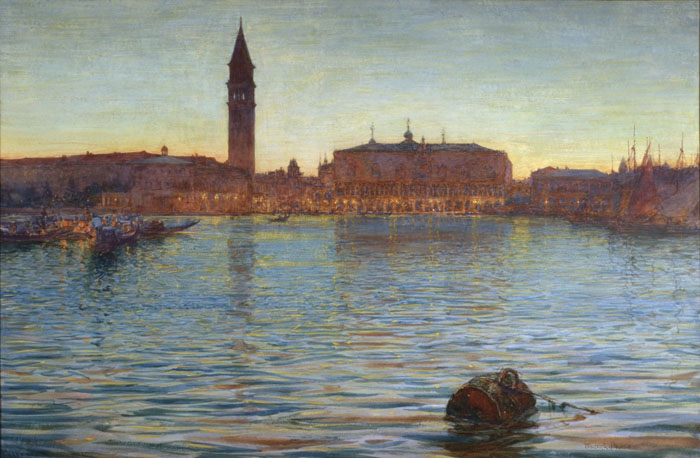
An exhibition of Walter Launt Palmer at New York State's
Albany Institute of History and Art features all three of those themes. The show just opened and it will be up through August 16.
The museum has one of the largest holdings of his work, and they'll be showing oil and watercolor paintings, pastels, and drawings, as well as letters and photographs.
When he was just 24 years old, Palmer studied landscape painting with Frederic Church. He shared a studio with Church in New York City from 1878-1881.
Walter Launt Palmer made many trips to Europe. He met John Singer Sargent, William Merritt Chase, John Henry Twachtman, Robert Frederick Blum, and probably a lot of other guys with three names.
After seeing the young Sargent's sketchbooks, Palmer wrote home, "He is but 17 and has done a lot of work, very little in oil."
Palmer was the one who recommended that Sargent should study with Carolus Duran. Palmer was so impressed with the younger painter's bold and vigorous style that he tried a similar approach himself for a while.
Palmer's winter scenes were constructed with a combination of outdoor studies, photographs, and memory.

The Brooklyn Museum has a good collection of sketchbooks and watercolors by William Trost Richards which give insight into his practice of painting studies on location.
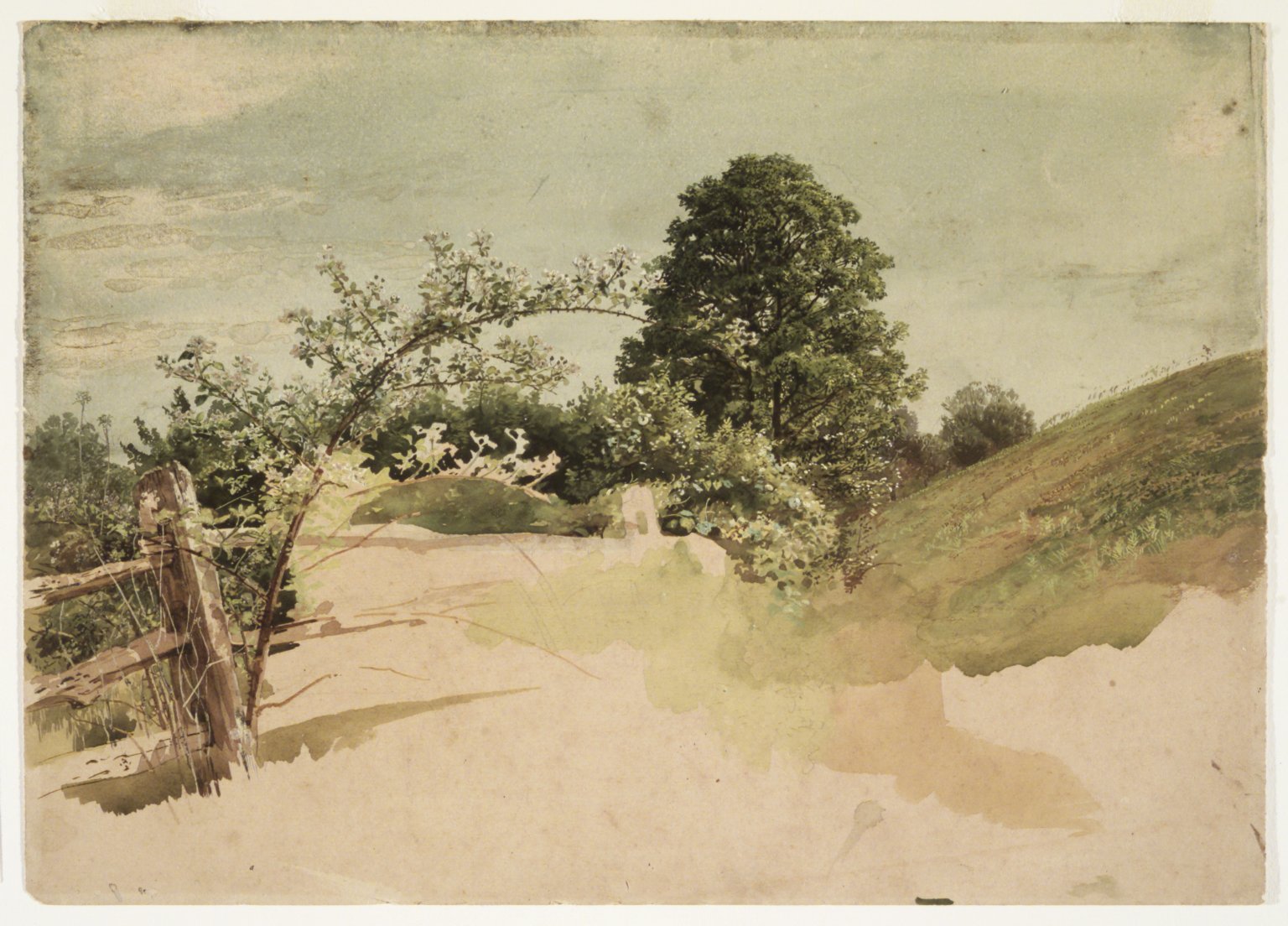 |
| William Trost Richards (1833-1905) "Landscape with Tree" |
This partly finished study is 10 x 14 inches. (25.4 x 35.6 cm) on smooth beige paper. It's mostly and transparent watercolor with some opaque touches in gouache. He used gouache for the thin twigs on the far left, but he carefully painted around the illuminated leaves in the center of the picture.
In this case, his initial steps don't include a very detailed pencil drawing. The unfinished area of the fence shows a few light washes and some locator lines painted with a brush in watercolor.
This study is the same size, carried through to finish. It uses a similar method: painting large shapes rather loosely (but accurately) with larger brushes, and then subdividing those masses into smaller textures and details.
Although this method requires large reserves of patience and concentration, I don't think it would necessarily take too long; I believe a painting like this could be done in an afternoon or perhaps two consecutive sessions.

Nowadays we might show a prospective client a folder of images on an iPhone. But in 1860, William Trost Richards (1833-1905) created this "Painter’s Sampler," to show what he could do.

Thirteen miniature canvases are mounted up together. They show a range of conventional landscape compositions. I can just image him saying... "I can paint you a Hudson River sunset, or a summer meadow, a nautical, or a cabin in the woods, or a forest interior...."
-----
This comes from a private collection and was exhibited at a Hudson River School exhibition called
"American Scenery" at the Dorsky Museum of Art
 (Continuing the series on American landscape painter Asher B. Durand)
(Continuing the series on American landscape painter Asher B. Durand)
In Durand’s paintings, the colors are understated and the technique is restrained, never showy. “Waste not your time on broad sketches in color,” he advised.
"One must not “fix the attention of the observer on the nice mixture of pigments rather than the sentiment of his work....all the best artists have shown that the greatest achievement in the production of fine color is the concealment of pigments, and not the parade of them; and we may say the same of execution. The less apparent the means and manner of the artist, the more directly will his work appeal to the understanding and the feelings.” When the technique becomes so conspicuous that it asserts itself as the principal feature of the picture, “it is presumptive evidence...of deficiency in some higher qualities.”
These “higher qualities” took on an almost religious aspect in Durand’s writings about art. He believed that the artist is privileged to see “through the sensuous veil, and [embody] the spiritual beauty with which nature is animate.” By cultivating “childlike affection and religious reverence,” the act of painting from nature becomes more than a mechanical process: in Durand’s view, it is a form of spiritual devotion.
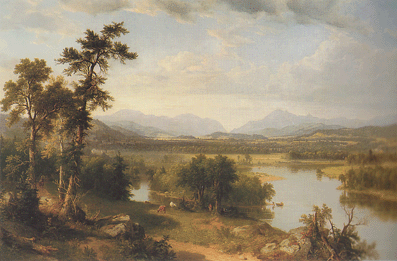
“The external appearance of this our dwelling place,” he wrote, “apart from its wondrous structure and functions that minister to our well-being, is fraught with lessons of high and holy meaning, only surpassed by the light of Revelation.”
Durand reflected on the appeal of enduring masterpieces after taking a voyage to visit the picture galleries in Europe in 1840. He described the measure of greatness as “sober, quiet tone, depth and mellowness, transparency and glow.” A well-painted picture “draws you into it—you traverse it—breathe its atmosphere—feel its sunshine, and you repose in its shade without thinking of its design or execution, effect or color.”
-------
Tomorrow: Durand's Legacy
(continuing the series on Asher B. Durand)Asher B. Durand would often select a small group of forms from within a complex scene and study it to the exclusion of its background detail. His son recalls that “finding trees in groups, he selected one that seemed to him, in age, color, or form, to be the most characteristic of its species, or in other words, the most beautiful."
"In painting its surroundings, he eliminated all shrubs and other trees which interfered with the impression made by this one. Every outdoor study...was regarded as a sort of dramatic scene in which a particular tree or aspect of nature may be called the principal figure.”
Durand’s form of realism was not a slavish or “servile imitation,” but rather a refined sensibility, guided by feeling, that sought to identify the characteristic form of specific varieties of trees, rocks and clouds while still attending to the minutiae of the individual subject.
He drew a distinction between imitation, which satisfies only the eye, and representation, which satisfies the mind’s conception of ideal form. He conceded that a perfect copy of natural forms like flowing water or intricate foliage was impossible, but that the attempt to achieve it helped the artist develop methods that could be brought into service in recreating those forms back in the studio.
Close examination of Durand’s original studies reveals that he did not necessary follow the practice of completing an entire scene la prima in one sitting. He typically painted foliage passages over a dry sky background that had been previously applied, and often worked for at least two consecutive sittings to accomplish his more detailed studies, probably executing the tree and the landscape at two different locations.
Tomorrow: Part 5: Durand's Color
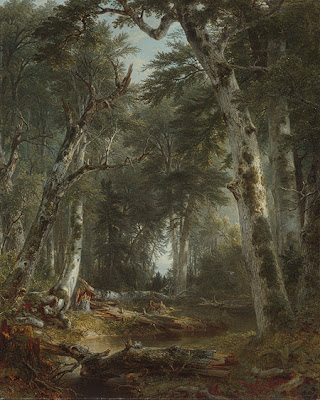 (Part 3 of a series)
(Part 3 of a series)
Durand articulated the principles of his art in a series of influential articles called “Letters on Landscape Painting,” published in The Crayon magazine in 1855.
Taken together, these writings are the most complete expression of the philosophies of the Hudson River School, and provide valuable insights for today’s painter or collector. Art historian James Flexner describes “Letters” as “one of those rare documents that summarizes the spirit of a group and a generation.”
Durand wrote that direct study from nature was the ideal way for the artist to transcend the limitations of tired compositional formulas, providing “the only safeguard against the inroads of heretical conventionalism.”
He defined conventionalism as “the substitution of an easily expressed falsehood for a difficult truth.” He advised students to begin with a thorough familiarity with the pencil before graduating to paint, and even then, to develop a mastery of foreground objects in strong light and shade before attempting atmospheric distances.
The goal in plein-air work, according to Durand, was to render nature as faithfully as possible, and to “scrupulously accept whatever she presents him, until he shall, in a degree, have become intimate with her infinity, and then he may approach her on more familiar terms, even venturing to choose and reject some portions of her unbounded wealth.”
He addressed the limits of artistic license by saying that the artist “may displace a tree, or render it a more perfect one of its kind if retained,” but the placement of elements in the middle ground and the “characteristic outline, undulating or angular, of all the great divisions, may not be changed in the least perceptible degree, most especially the mountain and hill forms. On these God has set his signet.”
(This begins a six-part series on the American landscape pioneer Asher B. Durand (1796-1886) based on an article I wrote for Plein Air magazine in April, 2005.)
In June of 1837, Asher B. Durand and his friend Thomas Cole departed on a sketching trip to Schroon Lake in the Adirondacks of New York State. They had carefully planned for the excursion, packing camp stools, umbrellas, and easels, and assembling a list of oil colors that included Antwerp Blue, Mummy Brown, and Asphaltum.
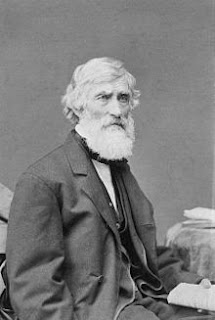
Collapsible tin paint tubes had not yet been invented, so they had to decide whether to grind pigments on location or to transport prepared paint in small pigskin bladders, which were prone to breaking open or drying out.
1 They brought along provisions of sour bread, salt pork, and ham, supplemented with fresh trout caught along the way.
The Schroon Lake expedition was a turning point for Durand, for it shaped his resolution to leave successful careers in engraving and portrait painting and to concentrate exclusively on landscape painting. Cole was already established as America’s premier landscape artist and had made some early experiments with plein-air work. But it was Durand who became the most enthusiastic early champion of painting from nature.
According to fellow artist Daniel Huntington, Durand “was a pioneer in painting carefully finished studies directly from nature out-of-doors.”
2 Other early landscape artists of his day—including Cole— “made only pencil drawings, or, at most, slight watercolor memoranda of the scenes they intended to paint, aiding the memory by writing on the drawing hints of color and effect.” Cole believed that “time [should] draw a veil of memory” over the common details of a scene in order to achieve a poetic sensibility in a painting.
Durand, following the earlier example of Constable and Corot, became deeply engaged by the challenge of working in oil outdoors in what he called “The School of Nature.” He went “directly to the fountain-head, and began the practice of faithful transcripts of ‘bits’ for use in his studio.” His custom was to spend two or three months each summer traveling with artist friends in the Catskills, Adirondacks, or White Mountains, gathering studies in both oil and pencil that would be used as aids to the memory when developing finished compositions during the winters in his New Jersey studio.
-----
1. Eleanor Harvey, The Painted Sketch: American Impressions from Nature, 1830-1880, (New York: Harry N. Abrades, 1998), 33.
2. Daniel Huntington, Asher B. Durand, a Memorial Address by Daniel Huntington. New York: The Century Association, 1887.
Tomorrow: Part 2: Durand's America
Friday was show-and-tell day at the Hudson River landscape painting group in Hunter, New York yesterday.

People came out of the drizzly weather into a modernized red barn, set down their paint boxes, and covered the tables with their first week’s crop of pencil drawings, tone paper studies, and oil sketches of waterfalls, forest interiors and sunsets.
Above by Brendan Johnston. The goal of these studies, as originally envisioned by founder Jacob Collins of the
Grand Central Academy, was to study natural form closely, in the manner of the pre-impressionist American landscape painters such as Asher B. Durand, Frederic Church, and William Trost Richards.
A line formed in the kitchen for hot dogs, veggie burgers, and salad. There were about 25 people from as far away as Canada, and Manchester, UK. They included participants in the month-long
Hudson River Fellowship, along with students enrolled in a 10-day workshop taught by master landscapist Tom Kegler of Buffalo, New York. I was there as a guest lecturer to give a presentation on light and color in the landscape.
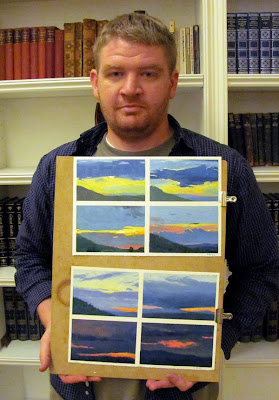 Peter Sakievich,
Peter Sakievich, a painting teacher from Utah, produced two sets of sunset studies in oil. He painted four consecutive studies of each of two sunsets from a nearby west-facing promontory. “I had to key the colors down,” he said, “because the risk is to get everything too light.” By the time he got to the last studies of the night, it was hard to see the colors on his palette.
Participants in this group are discouraged from using cameras to record details in the field. Many of them plan to use their studies for composing imaginative landscapes in the winter months.
LINKIFICATION
Previously on GJ: HR FellowshipHudson River FellowshipGrand Central Academy BlogPeter Sakievich website Peter Sakievich’s blog describes his materials in more detail Book on Frederic Church
A hundred years ago, railroads used pictures of famous artists sketching in their advertisements.
Book on Thomas Moran Wikipedia on Moran
Wikipedia on Moran
The American holiday of Memorial Day is a time to commemorate those who have died in war. It was once called “Decoration Day.”
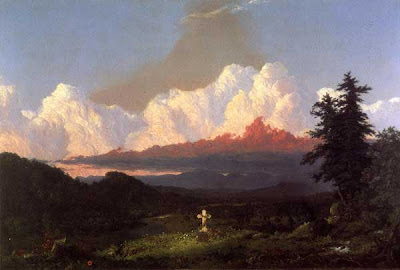
The older custom was to decorate the graves, and honor the memory, of all of the dead, and then to have a party afterward. After the Civil War, the holiday became established more along military lines.
Let’s remember the soldiers, bur let’s also remember the musicians and artists and teachers and carpenters and farmers who have lived their lives and passed into our memory.
Wikipedia about Memorial Day / Decoration Day
Image: “To the Memory of Cole” by Frederic Church
Thomas Cole  book by Earl A Powell
book by Earl A Powell
This coming July 8th at 7 pm in the Catskill Mountains of New York, I’ll be a one-day guest lecturer at the Grand Central Academy’s Summer Workshops for a presentation on color and light.
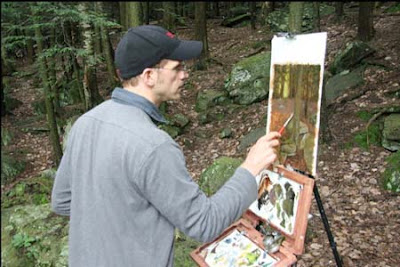
I’ll give an evening lecture during the workshop of Senior Hudson River Fellow, Thomas Kegler (above). His week-long course called “Field Study for the Studio Landscape Painter.” Tom’s work has the rare quality of being closely observed and poetically inspired, and he could have held his own with any of the traditional Hudson River School painters (Kegler's "Buffalo Creek Dusk," below).
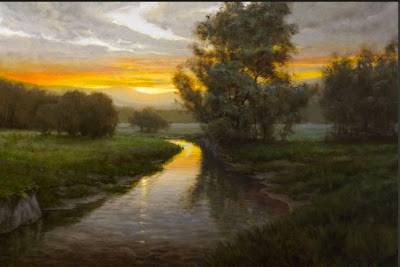
My lecture will cover material from the new book, Color and Light: A Guide for the Realist Painter, geared for plein air painters who want to explore the methods of the pre-impressionist Hudson River School Painters. Besides the digital slide show, I’ll have original paintings to show and books to share. If it’s like last time I visited, there will be plenty of opportunity for comaraderie and shop talk.
The full course will go from July 5 - 17, 2011 (10 instructed days, 1 free uninstructed day). The tuition is $1350, which includes Mr. Kegler’s instruction, park fees, 2 group meals, and my lecture. The class is open and is now accepting registrations.
-----
Previous GJ Posts on the Hudson River Fellowship.
Color and Light on Amazon
Grand Central Academy's Summer Workshops
Senior Hudson River Fellow, Thomas Kegler
A
new book about American landscape painter William Trost Richards describes the artist’s tribulations while painting the sea from life. Richards says:
“I watch and watch it, try to disentangle its push and leap and recoil, make myself ready to catch the tricks of the big breakers and am always startled out of my self possession by the thunder and the rush, jump backward up the loose shingle of the beach, sure this time that I will be washed away, get soaked with spray, and am ashamed that I had missed getting the real drawing of such a splendid one, and this happens twenty times an hour and I have never got used to it.”
The book was produced by the Cantor Arts Center of Stanford University in California, based on the sizable collection of WTR’s studies inherited by his youngest son in 1905 and donated to the museum in 1992.
The 9.5 x 11-inch book has over 204 pages, with 250 color reproductions documenting the entire collection at Stanford. It includes his Ruskin-influenced early pencil studies of plants, his Adirondack landscapes, and his seascape studies in gouache and oil. Trost Richards was the king of gouache landscape, often working on toned paper to capture transitory atmospheric and aquatic effects.
The emphasis is on his small plein-air studies, which rival those of Frederic Church, Peder Monsted and Ivan Shishkin for impeccably accurate observation. Because Richards worked in this mode well after it was fashionable (he called himself a “fogy”), he is not as well known as he deserves to be.
---------
William Trost Richards—True to Nature: Drawings, Watercolors, and Oil Sketches at Stanford University, by Carole M. Osborne.
Cantor Arts Center’s recent exhibit ended September 26.
Previous GJ posts on Trost Richards: "
Outer Limits of the Pencil," "
Trost Richards Watercolor," "
Called Away,"
Thanks, Margaret!
In 1860, the Baltimore and Ohio Railroad had a sweet deal for a couple of artists. The railroad approached Hudson River School painters Jervis McEntee and Sanford Gifford with the idea of a sketching trip.
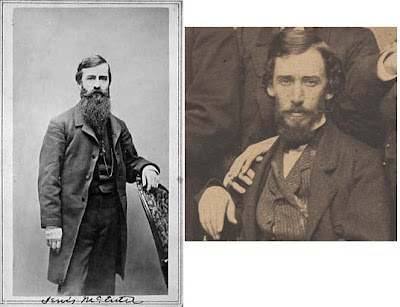
“The company supplies [the artists] with two cars, one which is fitted with sleeping accommodations. They switch off at any picturesque point of view that may strike their fancy, and when they have exhausted its capabilities for artistic purposes, they book on to a train and proceed as far as they choose.”
It was good publicity for McEntee, Gifford, and the railroad. Hey, if Amtrak wants to try the idea out again, I’m sure we can find a couple of artists to sign up.
----------
From
“McEntee & Company,” a catalog from the Beacon Hill Fine Art.
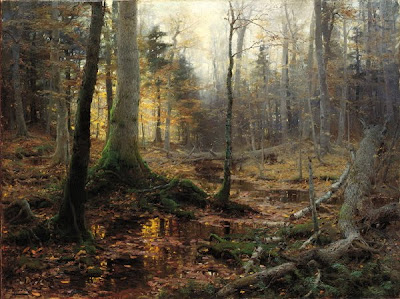 If William Bliss Baker had not died at age 27 from a skating injury, he might have gone on to be a bright star in the firmament of American landscape painting.
If William Bliss Baker had not died at age 27 from a skating injury, he might have gone on to be a bright star in the firmament of American landscape painting.
His "Fallen Monarchs," above, shows the influence of one of his teachers, Albert Bierstadt, with a keen awareness of light and atmosphere, and a close observation of forest detail.
More about Baker on Wikipedia and Fine Arts Trader.
Thanks, Chris!
I had supper last night with the great-granddaughter of Frederic Church at her home less than a mile from Olana. She said she found one of Church’s journals from his Near East expedition as she was exploring the attic a year or two ago.
“The reason I liked him,” she said, “is he seemed to have no fear.”

During his 1868 expedition to the lost city of Petra, she told me that Church was in mortal danger from the local Bedouin tribes, who had killed an artist in the region not long before. It was considered blasphemy to make graven images. But Church “hired a bunch of people to guide him. He payed them a great deal of money so they didn’t want to kill him.”
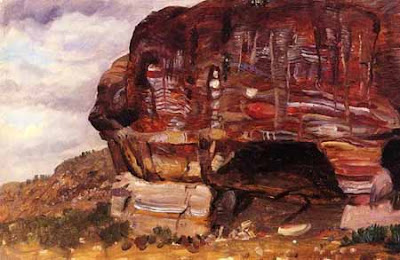 At one point the locals blocked his way and threatened his life. Church then asked to borrow a mirror, because “he realized a mirror was a sacred thing.” He took the mirror, and, while the Bedouins weren’t looking, he painted a crack on it. He then showed the cracked mirror to the angry men.
At one point the locals blocked his way and threatened his life. Church then asked to borrow a mirror, because “he realized a mirror was a sacred thing.” He took the mirror, and, while the Bedouins weren’t looking, he painted a crack on it. He then showed the cracked mirror to the angry men.
Then, announcing he would restore the mirror to its original condition, “he went behind the tent and erased the crack.” The men believed him to have divine powers, and they alllowed him to pass safely.
A juried group of landscape painters with an unusual mission will be working in the Catskill Mountains this summer for the third year in a row. If you want to join them, you've got a little over a month to apply.
The group, called the Hudson River Fellowship, is dedicated to the principle of close and prolonged observation of nature, patterned after the practices of pre-impressionist painters like Asher B. Durand and Frederic Church.
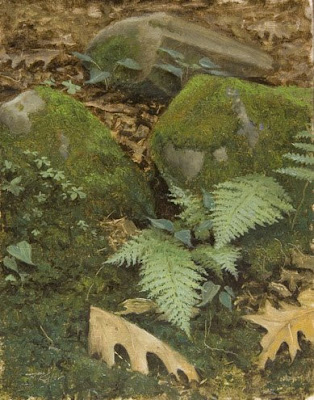 Artist Tom Kegler of Buffalo, New York completed this forest floor study last summer, when I paid a visit to the school.
Artist Tom Kegler of Buffalo, New York completed this forest floor study last summer, when I paid a visit to the school.
The artists selected to attend the fellowship will enjoy a month-long residency with full-tuition scholarship for all members and free housing. There’s a spirit of comraderie at the periodic exhibits of work in progress and at the group suppers.
The teachers include founder Jacob Collins of the Grand Central Academy, Edward Minoff, Travis Schlaht, and Nicholas Hiltner.
The curriculum includes lectures by guest speakers and a series of assignments, beginning with field studies in pencil, tonal renderings, and plein air observations. These studies aren’t done merely as an end in themselves.
The ultimate goal is to use these preliminaries to develop a large composition, what Bierstadt used to call a “Great Picture,” back in the studio after the fellowship is over.
Acceptance into the program requires a portfolio review and an application. The deadline for applying for this summer’s fellowship is May 1, 2009.
---------
Thomas Kegler (artist of the study above), link.
Home page of the Hudson River Fellowship, link.
Previous GJ Post, link.
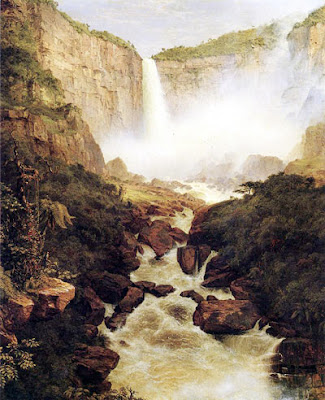
Fernando Emmanuel Laverde Bohórquez of Columbia has traveled to some of the same places that Frederic Church painted, including Tequendama Falls, 1854. In spite of the human damage (and natural erosion), he has discovered that the landscape is almost the same as it was. Thanks, Fernando.
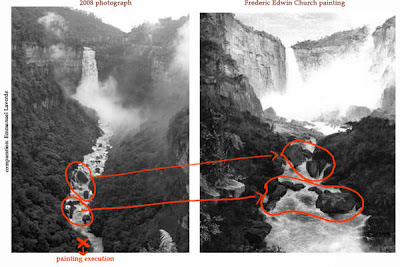
William Trost Richards was a 19th Century American realist landscape painter that we've looked at in various previous posts (Called Away, Trost Richards Watercolor,

The Arnold Art Gallery at Lebanon Valley College in Annville, Pennsylvania will be featuring a new exhibition called "William Trost Richards: Land and Sea," from January 9 to February 15, 2009.
The artist was a native of Philadelphia who continued his studies in Florence, Rome and Paris. In the 1850s, he befriended Frederic Church and Thomas Cole and became a member of the Hudson River School. By the 1870s, the artist became interested in the American landscape movement known as luminism, which explored, among other concerns, the immensity of the sea and the untapped frontiers of America. The show, titled William Trost Richards: Land and Sea, will feature oil paintings, small studies in watercolor, and pencil on loan from private collections, New York City galleries and several regional institutions.
The Suzanne H. Arnold Art Gallery is open at no charge on Wednesdays from 5 to 8 p.m., Thursdays and Fridays from 1 to 4:30 p.m., Saturdays and Sundays from 11 a.m. to 5 p.m., and by appointment for tour groups. For more information, please call 717-867-6445.
Arnold Art Gallery Website,
link. (Note: I don't know what images are in the show; the picture on this post is just a representative example of his work.)
Metropolitan Museum collection of Trost Richards,
link.
Large Trost Richards image database,
link.
In 1822, John Constable warned:
“Should there be a National Gallery (which is talked of), there will be an end of the art in poor old England. The reason is plain: the manufacturers of pictures are then made the criterions of perfection instead of Nature.”

Constable's complaint seems foolish, but it contains a grain of truth. There is a risk in loving art so much that we forget to look at Nature. Art based only on other art ends up being mannered and derivative. The great breakthroughs in art have come from the intense study of the real world through the artist’s own eyes.
Constable’s argument, however, should be taken as a caution, not a curriculum. The study of unfiltered Nature is a bewildering experience. Nature cannot in itself provide the artist with any “criterions of perfection.” Even the artist who paints every day from Nature may find himself fitted with blinders if he lacks a foundation in technique and tradition.
How do we begin to interpret the infinity of impressions that Nature provides? We need a compass, a guide, a map. Other artists who have gone before us can offer that guidance. Their work can blaze a pathway of possibility.
Artists should go to Nature, but they should check in to the art museum from time to time to sift through the harvest of the great souls of yore.

But one should never let the treasures of the museum pull harder at the heart than the living truth of the world around us. As Longfellow argued in his famous sonnet "
Art and Nature," (translated from Francisco de Medrano), the “works of human artifice” are like a mere garden, tiresome in comparison to the eternal and infinite grandeur—the “free and wild magnificence”—of the river and the meadow.
We should not hesitate to quit the cloisters of tradition and to revel in the direct experience of Nature face-to-face. Perhaps we might discover something that has never been discovered before.
---------
The photo is of
Henry Ward Ranger. The painting is by
Giuseppe Gabrielle, of Room 32 of the National Gallery in London.
It’s tough to be called away in the middle of a plein air sketch.
 Sometimes a rainstorm does it. The raindrops at the top of this watercolor study by William Trost Richards testify to what happened. A storm moved in, and he had to stop working.
Sometimes a rainstorm does it. The raindrops at the top of this watercolor study by William Trost Richards testify to what happened. A storm moved in, and he had to stop working.
 Here’s another Trost Richards seascape. Why is the bluff on the left only just laid in? Maybe someone called him to dinner, or his ride was leaving. We make art at the mercy of the stomach and the weather.
Here’s another Trost Richards seascape. Why is the bluff on the left only just laid in? Maybe someone called him to dinner, or his ride was leaving. We make art at the mercy of the stomach and the weather.
Thanks to William Vareika Fine Arts, link.
 If Frederic Church booked a seat on a modern airline, what would he think of the view out the window? How would he respond to a landscape of pure clouds with no terrestrial foreground?
If Frederic Church booked a seat on a modern airline, what would he think of the view out the window? How would he respond to a landscape of pure clouds with no terrestrial foreground?
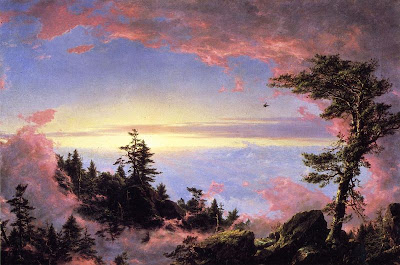 Early in his career Church painted this scene based on the sunrise view from the eastern scarp of the Catskill Mountains. It has the feeling of being detached from the ground, but there are still vestiges of rocks and trees beneath our feet.
Early in his career Church painted this scene based on the sunrise view from the eastern scarp of the Catskill Mountains. It has the feeling of being detached from the ground, but there are still vestiges of rocks and trees beneath our feet.
 A couple months ago I sat atop Storm King, a mountain overlooking the Hudson River near the cities of Newburgh and Beacon. As I sketched, I found myself unconsciously wanting to invent a repoussoir element in the foreground to give the viewer something to hang onto.
A couple months ago I sat atop Storm King, a mountain overlooking the Hudson River near the cities of Newburgh and Beacon. As I sketched, I found myself unconsciously wanting to invent a repoussoir element in the foreground to give the viewer something to hang onto.
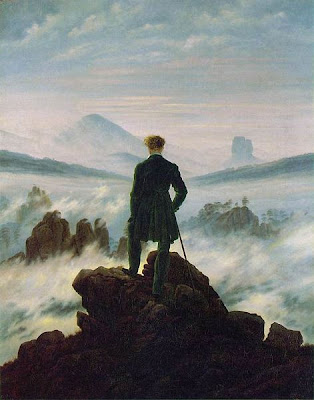 I was thinking of Caspar David Friedrich’s famous painting of the wanderer above the sea of clouds. He puts us on the dizzy heights with the world below almost swallowed up in vapors.
I was thinking of Caspar David Friedrich’s famous painting of the wanderer above the sea of clouds. He puts us on the dizzy heights with the world below almost swallowed up in vapors.
One contemporary artist, Hillary Brace, draws cloudscapes entirely devoid of solid ground.
I think Church would have loved the challenge to paint a pure sea of clouds. After all, his most famous painting, Niagara, dispensed with a solidity and security altogether.
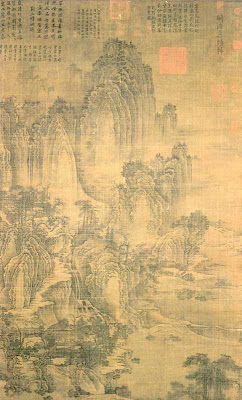 Landscape painting at its best uses visible matter to convey invisible realms of space, air, depth and silence.
Landscape painting at its best uses visible matter to convey invisible realms of space, air, depth and silence.
-------
Thanks, Chris. Hillary Brace, link. Jing Hao, link.












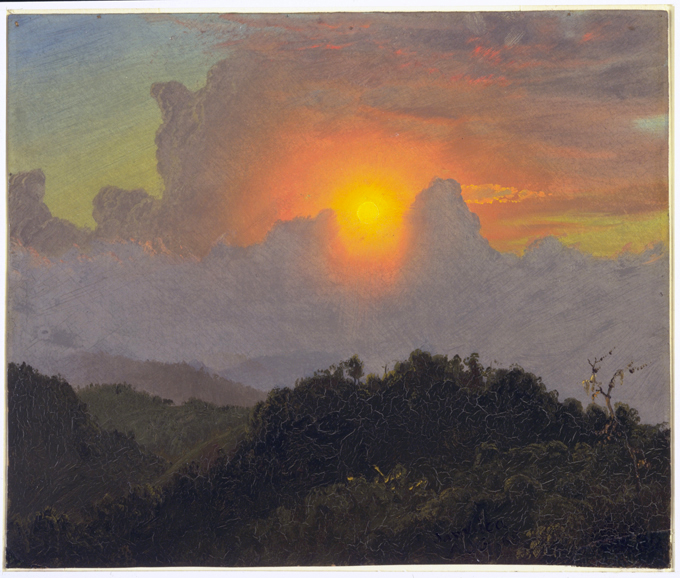


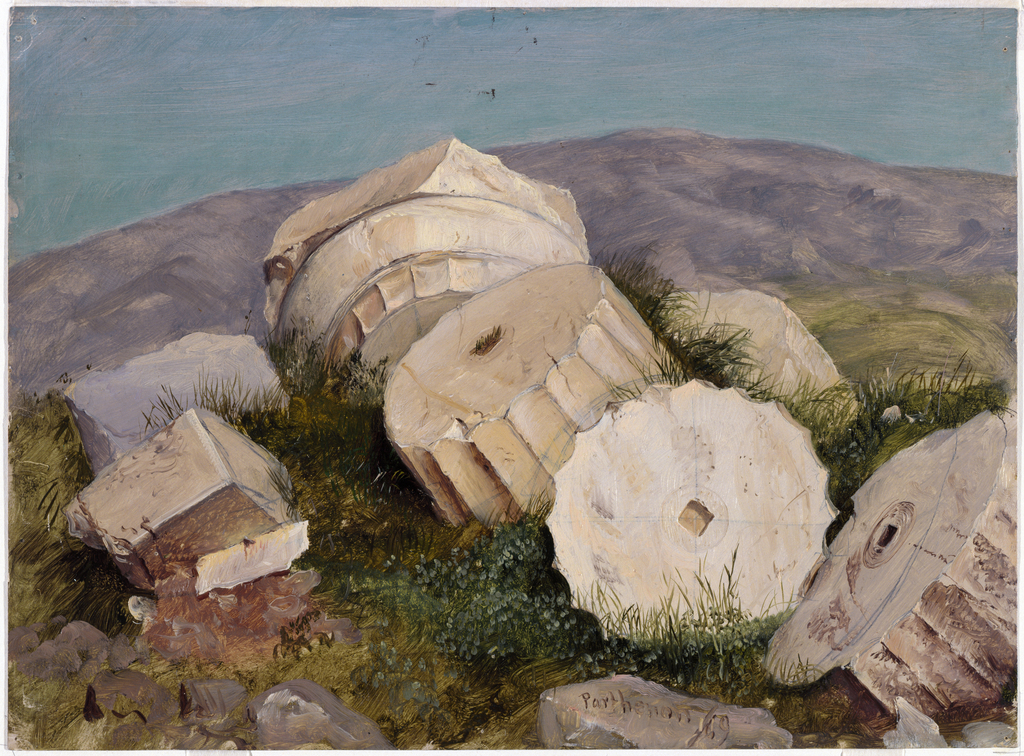
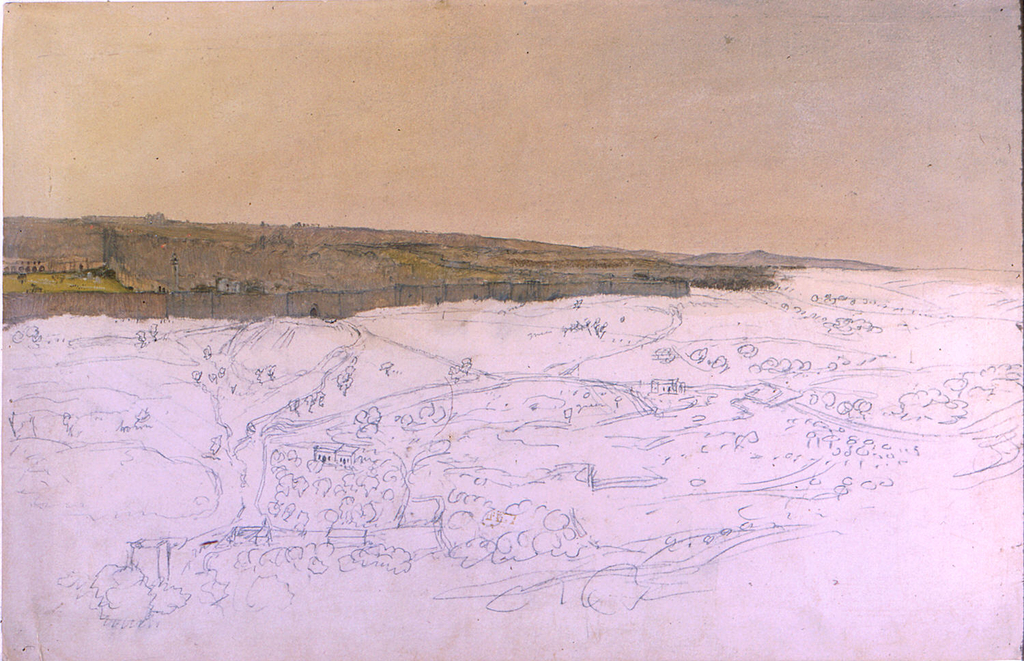
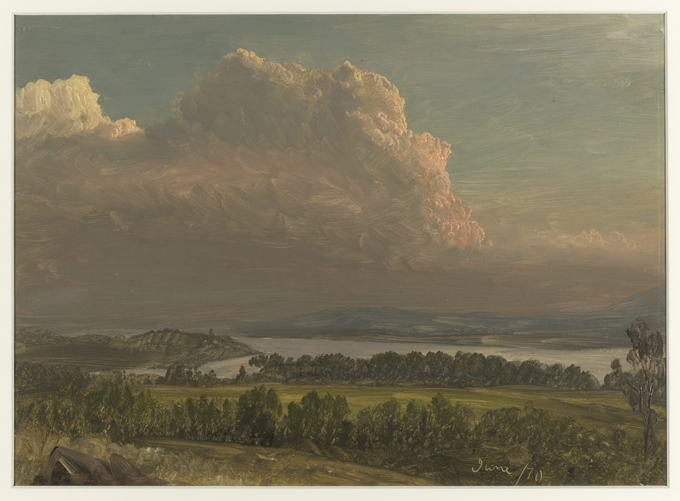









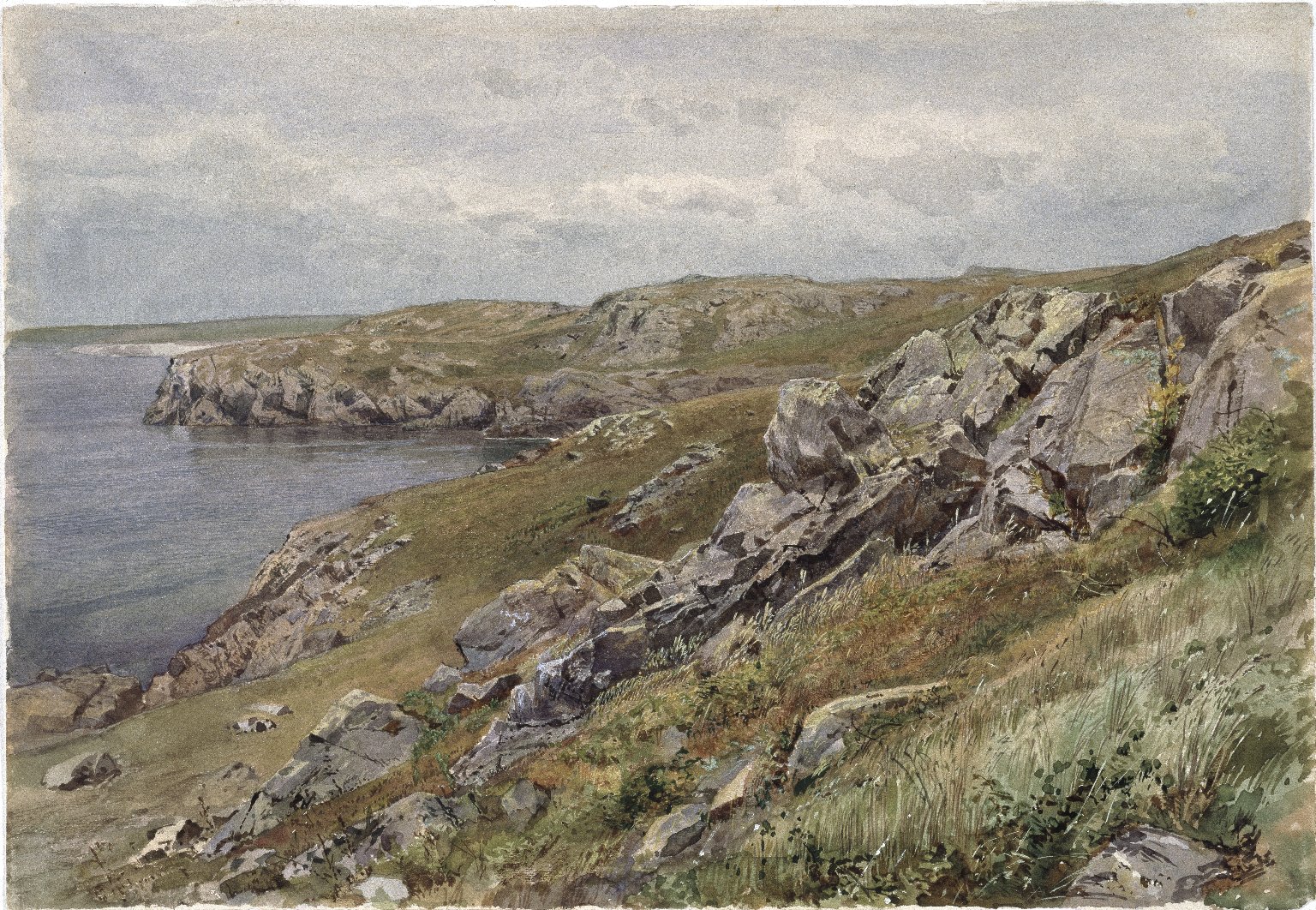



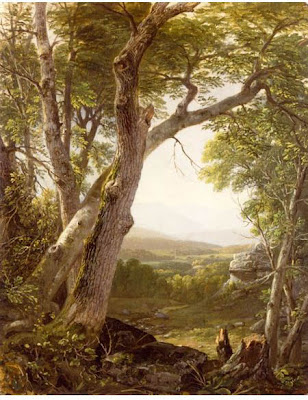








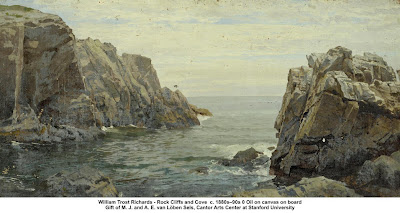


















He doesn't sound like he'd be a proponent of dual brush digital speed painting techniques, =~O
Some interesting quotes. A focus on nature and the inner life of feelings...Durand seems to fit so squarely within Romantic aesthetics it's hard to believe he wasn't well read in them. Regarding pigments and mediums:
The nature of the depicted thing suffers violence from the depicting matter as soon as the latter makes use of its nature in depicting the thing. An object may thus only be termed freely depicted if the nature of the depicted object has not suffered from the nature of the depicting matter.
Friedrich Schiller
Kallias or Concerning Beauty
I love the quotes. I'm looking forward to the arrival of Durand's "Letters.."
Many are drawn to art because of the love of 'violent' color though Durand makes an excellent point about not abusing color in the slightest. There is a high art to subtlety. His work certainly pulls me in like no other and I love color.
- mp
Sounds to me that he shared thoughts with whomever coined the phrase that can can be found on your maul stick Mr. Gurney.
Trees and plants are wonderful, "they grow in unison with all that is."
As to Durand's theory of "concealment of pigments" as some kind of highest virtue in painting: There may be a truth in it. But I find that statement too one sided.
Matisse for instance, would have been rendered impossible by it.
Perhaps this would apply to Matisse: " When the technique becomes so conspicuous that it asserts itself as the principal feature of the picture, “it is presumptive evidence...of deficiency in some higher qualities.”" though more likely, applying Durand's landscape principles to Matisse's work is like comparing apples to oranges. - mp
Well, in my view Durand was not confining himself to landscape only, when he said
"All the best artists have shown that the greatest achievements in the production of fine color is the concealment of pigments."
I just felt like pointing out some perhaps antiquated or obsolete notions about "greatest achievements" in the realm of painting.
It's not only Matisse; I could have quoted Chagall or Kokoschka and probably a host of others.